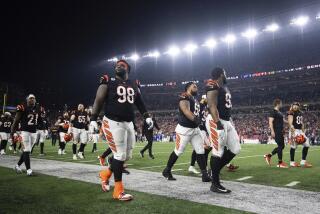Cricketer Phillip Hughes dies after being struck by cricket ball
- Share via
Sydney — Test batsman Phillip Hughes died in a Sydney hospital on Thursday, two days after being struck on the head by a cricket ball during a domestic first-class match. He was 25.
“It is my sad duty to inform you that a short time ago Phillip Hughes passed away,” Australian team doctor Peter Brukner said. “He never regained consciousness following his injury on Tuesday.”
Brukner said Hughes was not in pain before he died, and was surrounded by family and close friends.
“As a cricket community we mourn his loss and extend our deepest sympathies to Phillip’s family and friends at this incredibly sad time,” Brukner said.
Hughes’ mother and sister were at the match when he was injured, and kept vigil at the hospital. Close friend and Australia captain Michael Clarke was among dozens of former and current teammates and stars of the game who visited the hospital to offer their support to Hughes and his family. Clarke was due to read a statement from the family at a news conference later Thursday.
The death — from a cerebral hemorrhage, or bleeding on the brain — shocked and saddened people across Australia and cricket fans all over the world, and cast doubt over the first test between Australia and India due to be played in Brisbane next week.
Prime Minister Tony Abbott described Hughes as a “young man living out his dream,” adding “It’s a very sad day for cricket and a heartbreaking day for his family.”
“For a young life to be cut short playing our national game seems a shocking aberration,” he said.
Messages of support poured in from all around the world after Hughes stumbled, leaned over and then collapsed after being hit behind the left ear when he mis-timed a shot to a short-pitch delivery while batting for South Australia against New South Wales in a Sheffield Shield match on Tuesday. He underwent emergency surgery at nearby St. Vincent’s Hospital and remained in a critical condition in an induced coma.
Deaths are rare in cricket, although Hughes is the second player in two years to sustain a fatal blow.
Darryn Randall, who was 32 and a former first-class player in South Africa, was killed after being struck on the side of the head during a Border Cricket Board Premier League match in the Eastern Cape last year.
In 1998, former India test player Raman Lamba died after being struck on the head while fielding during a domestic match in Bangladesh. Nottinghamshire’s George Summers died after being hit on the head while batting at Lord’s in 1870, and Abdul Aziz died after he was hit over the heart in a 1959 Pakistan first-class match.
Images of Hughes collapsing face first at the Sydney Cricket Ground were broadcast almost instantly across Australia on Tuesday, when satellite TV trucks and dozens of news crews started reporting regular updates on his condition from outside the hospital.
Hughes played 26 test matches for Australia after making his debut 2009, but despite a sparkling start to his international career at the age of 19, he was not able to earn a regular spot in the starting lineup.
After making an assured 75 in his first test innings against South Africa at Johannesburg, he posted centuries in each innings of his second test, becoming the youngest player ever to do that in test cricket. But he struggled on the subsequent tour of England and was in and out of the Australian team four more times. He was on the verge of another test recall, with an assured 63, when he was fatally struck.
He also played 25 limited-overs internationals for Australia and more than 114 first-class matches in a career starting in 2007.
The injury sparked debate about short-pitch bowling in the game, the level of protection offered by helmets that first came into common use at the test level in the late 1970s, and the seemingly slow reaction time of the ambulance service as Hughes was treated on the field.
Bouncers, where a fast bowler aims to push the batsman back toward the stumps with a ball that lands halfway down the pitch and rears up above chest or head height, are still a regular and acceptable part of the game.
The International Cricket Council revised its laws on short-pitch bowling in the early 1990s, putting restrictions on the number of short-pitch balls allowed per over to stamp out bowlers merely using the delivery to intimidate batsmen.
Hughes was wearing a helmet when he attempted to hook a short-pitch ball from New South Wales fast bowler Sean Abbott, but was hit on an unprotected area at the back of his head.
More to Read
Start your day right
Sign up for Essential California for the L.A. Times biggest news, features and recommendations in your inbox six days a week.
You may occasionally receive promotional content from the Los Angeles Times.





